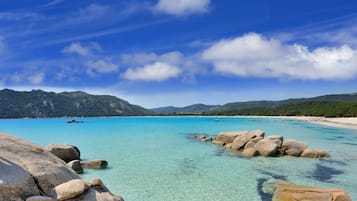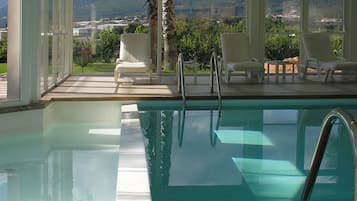Corsica has created its own unique culinary identity that can easily hold its own against the more well-known French cuisine. From breakfast through to dessert, via the obligatory aperitif and many other refreshment opportunities. During your holiday in Corsica, you'll be introduced to a cuisine that is as varied as the landscape, and is as self-assured as the character of its inhabitants.
Delicate charcuterie, surprising cheeses, fish or meat stews and local produce are all jostling to tantalise your taste buds. There are also irresistible sweets in a variety of flavours and wines that you could drink time and time again, looking out to sea or towards the maquis scrub land. Take a look at the best 10 Corsican specialities to try during your stay.
- 1
Corsican cured meats: figatellu, coppa and lonzu
Local savoir-faire

- Eten
Corsican pork and cured meats are among the island's icons. Fed on chestnut, among other things, pork flesh is turned into cured meats whose reputation defies borders, with the favourites being coppa, lonzu and figatellu dry sausages.
The sausages are all made using natural guts and left to dry for several months, but each uses a different part of the animal: spare rib for coppa, peppered on the surface and to be eaten raw in thin slices, lean steak soaked in wine for lonzu and fatty and lean steak accompanied with liver and sometimes with a touch of garlic or red wine for figatellu. Enjoy them as an aperitif or bring them back in your suitcase.
- 2
Corsican cheese: brocciu, cabrettu
Real flavour

- Eten
Corsican cheese is the twin of cured meat, which is very appropriate because Corsica is just as good for one as it is for the other. The most famous of them all is brocciu, made from a base of goat's or sheep's milk. Savour it plain and fresh (or warm just after you've strained it), or spice it up with eau-de-vie, honey, sugar or even traditional savoury or sweet dishes.
Cabrettu is made from a unique, ancestral recipe which goes back to the Roman period. A young goat that has just suckled is slaughtered and its stomach full of milk is salted and tied ready for maturing. This cheese is full of character.
- 3
Aziminu
Fish in all of its states

- Eten
Aziminu (Corsican fish soup) is the Corsican version of bouillabaisse, made of rock fish from the island's waters (scorpion fish, red mullet, grayling, mullet and sea bream) stewed in a herb bouillon (bay leaves, saffron and fennel), livened up with Corsican olive oil and a glass of pastis.
It's sometimes decorated with mussels or small crabs, and even langoustine for a more sophisticated version. Once the fish is cooked, it's served on a separate plate while the bouillon is served first and foremost with croutons or dried bread that you can joyfully dip in. Try it as a starter or main dish with a regional rosé, such as Patrimonio.
- 4
Civet de sanglier
A plateful of tradition

- Eten
Civet de sanglier's (wild boar stew) main ingredient is, quite unexpectedly, onion. The dish actually takes its name from the Latin "caepa" or the Occitan "çeba", which refer to the herbaceous plant used as the base of this stew. Carrot and garlic are also given pride of place, enhanced with a touch of eau-de-vie and, according to the recipe, myrtle or even chestnut.
The boar meat has a marked taste which is brought out all the more by a nice glass of red on the side. A great classic of Corsican cooking, stufatu di cignale (wild boar stew) can be used in a multitude of family recipes that you can enjoy just as much in summer as in winter.
- 5
Pulenda
Astonishing chestnut flour bread

- Eten
Corsican pulenda (Chestnut flour bread), not to be confused with corn-based polenta, is made with chestnut flour to which you add water and salt to form a sort of pancake or ball of bread that's traditionally cooked in a cauldron.
When it's ready, cut it into slices and enjoy it warm with a good brocciu cheese, fried eggs or cured meat. This slightly heavy speciality generally appears on festive tables in winter. When it's a few days old, don't hesitate to add a little extra chestnut flour before putting it back in the pan.
- 6
Veau aux olives
A recipe as old as Corsica itself

- Eten
Veau aux olives (Veal with Olives) main ingredient is the local green olives which are skilfully accentuated with carefully selected herbs, such as bay leaves and added to excellent quality and preferably Corsican veal. This dish simmered in red wine (a Patrimonio is ideal to keep with the Corsican theme) is mainly eaten in winter, but its fragrance and lightness make for an equally pleasant meal in the summer.
You need a lot of patience to make a good veau à la corse (Corsican veal), as it's also called, because it has a long cooking time, but that's where its unique and complete flavour comes from. Pasta, potatoes and polenta work wonders as an accompaniment.
- 7
Local honey
The island's splendour

- Eten
Local honey, or Mele di Corsica as it is proudly named on the pots on the island, is an unmissable local treat that does local inhabitants proud. It's the ideal souvenir to take home or give to loved ones when you're back. The honey produced by Corsican bees is as varied as the landscapes at the heart of which they gather their pollen, and the clementine trees on the seafront have a very different taste to the chestnut trees in the mountains and wild scrubland.
It's often organic, the taste is sometimes sweet, sometimes stronger, and the colours range across the spectrum with a specific flavour for each shade. The perfect treat for breakfast, or straight off the spoon for true fans.
- 8
Fiadone
Your new guilty pleasure

- Eten
Fiadone (Corsican cheesecake) is Corsica in dessert form. Made from the famous brocciu cheese, sugar, eggs and orange and lemon zest, it's sometimes compared to cheesecake even though its personality is very different. You can find both circular and rectangular versions of this thin cake and you'll recognise the beautiful caramel colour which appears during the baking process.
The smoothness of this star dessert makes a welcome end to a good meal, especially when coated with a dash of eau-de-vie and accompanied by a fruit coulis or citrus marmalade. It was traditionally eaten at Easter and New Year parties, but nowadays you can buy it all year round in the island's patisseries.
- 9
Canistrelli
The Corsican biscuits you won't be able to go without

- Eten
Canistrelli, or Corsican biscuits, are a staple of Corsican cafés. These little dry biscuits are made with a base of flour, sugar and white wine and are flavoured as you fancy. Try chestnut, lemon, aniseed, almond, raisin or, if you're feeling creative, onion, herb or olive.
Savour them as an aperitif accompanied by a glass of rosé. Their crunch paired with their unprecedented scent and sweetness makes them irresistible at all waking hours, from breakfast through until dessert. Why not make the most of your stay and taste all the flavours you can find, choose your favourite three and pack them into your suitcase?
- 10
Corsican wines
Cheers.

- Eten
Corsican wine production plays an integral part in Corsican history, introduced by the Phocaeans in the 11th century B.C. This tradition has developed and become stronger over the centuries and remains a discipline which reveals the spirit of Corsica even today. Thirty or so typical varieties of grapes make up the island's wine landscape, but three in particular stand out for their reputation: nielluccio (red and rosé), sciacarello (red and rosé) and vermentino or malvasia (white).
As well as these exceptional varieties, there are also nine appellations d'origine contrôlée (registered destination of origin) varieties on the island from rich and varied regions, such as the famous Patrimonio and Sartène wines. A little something to taste the sweetness of Corsican life.


















